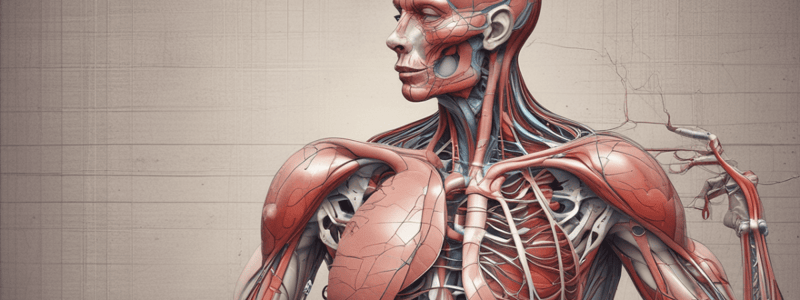Podcast
Questions and Answers
What percentage of an adult's total body weight is accounted for by their blood?
What percentage of an adult's total body weight is accounted for by their blood?
- 15%
- 10%
- 5%
- 7% (correct)
What is the primary function of the digestive system in relation to the circulatory system?
What is the primary function of the digestive system in relation to the circulatory system?
- To provide oxygen
- To remove wastes
- To provide nutrients (correct)
- To pump blood
What is the characteristic of the human cardiovascular system?
What is the characteristic of the human cardiovascular system?
- Closed (correct)
- Semi-open
- Open
- Semi-closed
Where does oxygenated blood enter the systemic circulation?
Where does oxygenated blood enter the systemic circulation?
What is the function of the aortic semilunar valve?
What is the function of the aortic semilunar valve?
What is the characteristic of the walls of the aorta?
What is the characteristic of the walls of the aorta?
What is the average velocity of blood in the aorta?
What is the average velocity of blood in the aorta?
What happens to the viscosity of blood when it gets colder?
What happens to the viscosity of blood when it gets colder?
What is the purpose of the low velocity of blood in the capillary?
What is the purpose of the low velocity of blood in the capillary?
What is the relationship between the velocity of blood flow and the cross-sectional area of the blood vessel?
What is the relationship between the velocity of blood flow and the cross-sectional area of the blood vessel?
What is the formula that describes the flow rate of a fluid through a narrow tube?
What is the formula that describes the flow rate of a fluid through a narrow tube?
What is the unit of velocity mentioned in the text?
What is the unit of velocity mentioned in the text?
What is the main factor that contributes to blood pressure in the circulatory system?
What is the main factor that contributes to blood pressure in the circulatory system?
What is the direction of blood pressure change as it flows from the aorta to smaller blood vessels?
What is the direction of blood pressure change as it flows from the aorta to smaller blood vessels?
What is the purpose of knowing both systolic and diastolic blood pressure?
What is the purpose of knowing both systolic and diastolic blood pressure?
What is the unit of measurement for the viscosity of blood (η)?
What is the unit of measurement for the viscosity of blood (η)?
In what direction does blood return to the heart?
In what direction does blood return to the heart?
What is the term for the pressure of circulating blood on the walls of blood vessels?
What is the term for the pressure of circulating blood on the walls of blood vessels?
What is the medical term for high blood pressure?
What is the medical term for high blood pressure?
What is the normal range for systolic blood pressure?
What is the normal range for systolic blood pressure?
What is the stage 1 high blood pressure range for systolic pressure?
What is the stage 1 high blood pressure range for systolic pressure?
What is the diastolic pressure range for a hypertensive crisis?
What is the diastolic pressure range for a hypertensive crisis?
What is a possible complication of uncontrolled high blood pressure?
What is a possible complication of uncontrolled high blood pressure?
What is the term for the weakening of the wall of the aorta, leading to widening or ballooning?
What is the term for the weakening of the wall of the aorta, leading to widening or ballooning?
What is congestive heart failure specifically referred to?
What is congestive heart failure specifically referred to?
How many heart chambers are there in the human heart?
How many heart chambers are there in the human heart?
What is the primary cause of a heart attack?
What is the primary cause of a heart attack?
What are the four silent signs of a heart attack?
What are the four silent signs of a heart attack?
What is the characteristic of varicose veins?
What is the characteristic of varicose veins?
How many stages of heart failure are there?
How many stages of heart failure are there?
The average heart beats about 70 times per minute.
The average heart beats about 70 times per minute.
Each beat of a human heart is about 2 joules.
Each beat of a human heart is about 2 joules.
The power generated by the heart is independent of the flow rate of blood.
The power generated by the heart is independent of the flow rate of blood.
Echocardiography is a painful test that uses X-rays to create moving pictures of the heart.
Echocardiography is a painful test that uses X-rays to create moving pictures of the heart.
The power produced by the heart is approximately 2 watts.
The power produced by the heart is approximately 2 watts.
The energy corresponding to the systolic pressure of 120 torr is 100 × 10³ erg/cm³.
The energy corresponding to the systolic pressure of 120 torr is 100 × 10³ erg/cm³.
The total energy of the blood flowing through the aorta is 1.63 × 10⁴ erg/cm³.
The total energy of the blood flowing through the aorta is 1.63 × 10⁴ erg/cm³.
The kinetic energy of the blood flowing through the aorta is 1.33 × 10³ erg/cm³.
The kinetic energy of the blood flowing through the aorta is 1.33 × 10³ erg/cm³.
The power produced by the heart is given by the formula P = Q × E.
The power produced by the heart is given by the formula P = Q × E.
The heart pumps approximately 6 liters of blood per minute at rest.
The heart pumps approximately 6 liters of blood per minute at rest.
Flashcards are hidden until you start studying




